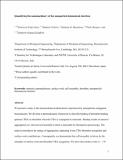Quantifying the nanomachinery of the nanoparticle-biomolecule interface
Author(s)
de Puig Guixe, Helena; Federici, Stefania; Baxamusa, Salmaan H.; Bergese, Paolo; Hamad-Schifferli, Kimberly
DownloadMain article (10.03Mb)
OPEN_ACCESS_POLICY
Open Access Policy
Creative Commons Attribution-Noncommercial-Share Alike
Terms of use
Metadata
Show full item recordAbstract
A study is presented of the nanomechanical phenomena experienced by nanoparticle-conjugated biomolecules. A thermodynamic framework is developed to describe the binding of thrombin-binding aptamer (TBA) to thrombin when the TBA is conjugated to nanorods. Binding results in nanorod aggregation (viz. directed self-assembly), which is detectable by absorption spectroscopy. The analysis introduces the energy of aggregation, separating it into TBA–thrombin recognition and surface-work contributions. Consequently, it is demonstrated that self-assembly is driven by the interplay of surface work and thrombin-TBA recognition. It is shown that the work at the surface is about −10 kJ mol−1 [mol superscript -1] and results from the accumulation of in-plane molecular forces of pN magnitude and with a lifetime of <1 s, which arises from TBA nanoscale rearrangements fuelled by thrombin-directed nanorod aggregation. The obtained surface work can map aggregation regimes as a function of different nanoparticle surface conditions. Also, the thermodynamic treatment can be used to obtain quantitative information on surface effects impacting biomolecules on nanoparticle surfaces.
Date issued
2011-06Department
Massachusetts Institute of Technology. Department of Biological Engineering; Massachusetts Institute of Technology. Department of Mechanical EngineeringJournal
Small
Publisher
Wiley-VCH
Citation
de Puig, Helena et al. “Quantifying the Nanomachinery of the Nanoparticle-Biomolecule Interface.” Small (2011) : v. 7, issue 17, p. 2477-2484, Sept. 2011. Copyright © 2011 WILEY-VCH Verlag GmbH & Co.
Version: Author's final manuscript
ISSN
1613-6810